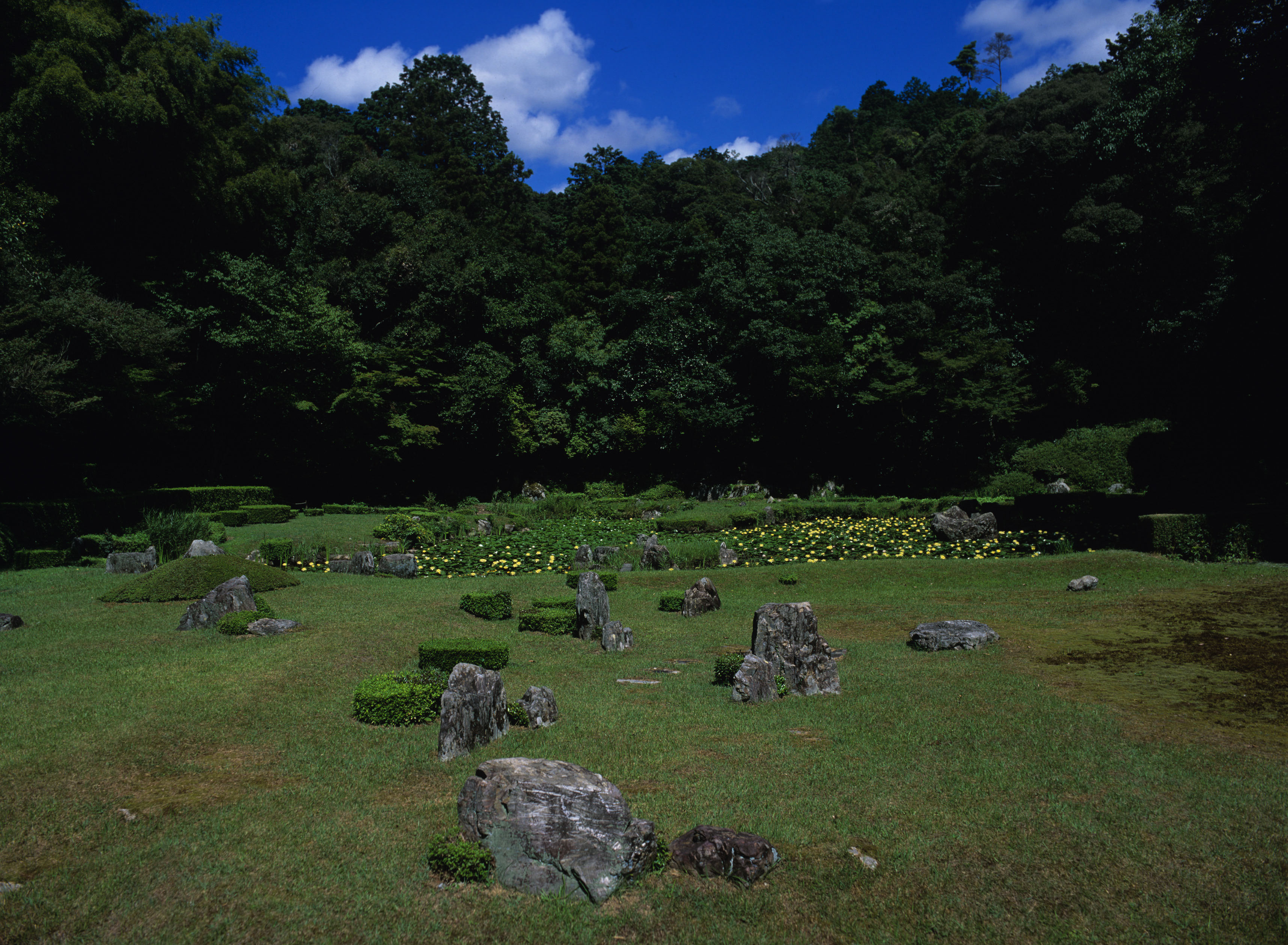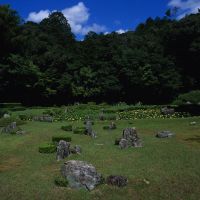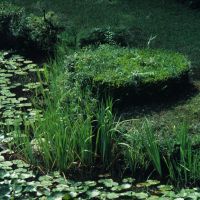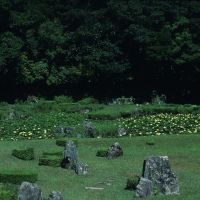"The whole countryside was full of snakes sunning themselves along the roads and swimming in the ditches and newly flooded rice-fields. ... Out in Sesshu's old garden behind the temple, the pond was starred with tiny twinkling water-lilies." Such was, in part, how Glenn W. Shaw described the rural outskirts of Yamaguchi City in his 1932 "Japanese Scrapbook."
Shaw (1886-1961), an author, journalist and educator who was a long-time Osaka and Tokyo resident, would be delighted to know that the city's surroundings have changed little since his visit — and that Sesshu's old landscape design, best known as Joei-ji Garden, remains much the same, too. If anything, it has weathered into a state of even deeper antiquity as time has passed.
Sesshu Toyo (1420-1506) was an immensely gifted painter, but of his early works we know very little, as these perished during the civil wars in which much of Kyoto was destroyed during and after his lifetime. Hence Joei-ji Garden, executed in his youth, remains his earliest known work.
Interestingly, in the 15th-century art world, there appears to have been no conflict in the idea of a painter designing gardens. For further instance, the important garden designer Kobori Enshu (1579-1647), was, among other things, an arbiter of the tea ceremony.
Clearly, despite the traditional reverence for specialists, in those days such men of immense talent and creativity were free to exercise their gifts as they chose.
Sesshu was an artist who enjoyed great recognition during his own lifetime. Describing his work as naturalistic and spontaneous, a priest named Shuho — clearly not the renowned Shuho Myocho who founded the huge Daitoku-ji temple complex in Kyoto in the early 14th century but an otherwise invisible namesake — commented: "It seems as though his very blood were ink and everything he touched turned to painting."
The American art historian Ernest E. Fenollosa (1853-1908) went even further, writing: "He is the greatest master of the straight line and angle in the whole range of the world's art."
Although Fenellosa never visited the garden, his remark hints at its geometrical aspect. Sesshu's vertical subjects, the great vaulting, Song Period (960-1279), Chinese-inspired peaks and ravines of his silk paintings, were inverted in the Joei-ji Garden, which is an exercise in the horizontal.
There are other commonalities between his garden designs and his canvases. Instance the flat-topped rocks, which are a Sesshu garden signature — and one that is replicated in his painting. Even the islands in the pond at Joei-ji are flat planes without the usual upward contouring characterizing such features in other Japanese gardens.
Yamaguchi may seem an unlikely place to find a major albeit little-visited garden, as Japan's foremost landscapes are generally in such hubs as Kyoto and Tokyo, where a combination of wealth and talent produced many fine examples of the art.
Although Yamaguchi City has now returned to its original provincial status, it flourished during the Sengoku (Warring States) Period spanning some 150 years from the mid-15th century, as many noblemen and their retinues gathered there for safety and brought along craftsmen. They were followed by the literati, who also repaired to the remoteness of western Honshu to escape the turmoil of Kyoto. Many of Yamaguchi's temples and shrines, reflecting the tastes and sensibilities of the Imperial capital, date from this period.
Masahiro Ouchi, a clan leader in what is now Yamaguchi Prefecture, commissioned Joei-ji to be designed as a pond-and-island garden. Because of Sesshu's fondness for rocks, it is now often listed as a karensansui (dry-landscape garden).
Since stone gardens are not generally places in which to stroll or even to physically enter, they must be contemplated in the manner of art, from a fixed position, a prescribed viewpoint. And, as in the presence of any arresting image, our own presence is temporarily subsumed when viewing these spatial works.
Gardens of this type are nothing if not iconographic, with the stone arrangements speaking of more than just pleasing patterns. Sanzon-seki-gumi, for example, a common feature in stone gardens, is a grouping of three stones; a design of scalene triangles in which the principal rock represents the Buddha and the two lower ones disciples.
The original idea of this arrangement was to trap malign forces as they entered the garden, and then — with the aid of the other auspiciously south- and west-facing stones — to deflect them. However, an alternative reading of the triad's function is as a representation of Mount Sumeru, the center of the Buddhist cosmos.
At Joei-ji there are also the classic tortoise and crane rocks, standing for longevity and good fortune. Another rock bears an uncanny resemblance to Mount Fuji, Japan's most sacred peak.
Framing is something that painters — such as Sesshu — instinctively understand. We could even go as far as to say that the frame turns the garden into art, or it at least signals the intention to make art.
One simple approach to this exercise in restricting and manipulating space is to alter perspective. Placing large rocks in the foreground and smaller ones in the background, and other objects across the garden's diagonals, results in an illusion of distance and depth and a visual tension that energizes the gardens. This is notably true of Joei-ji, where the scale of the large foreground rocks is emphasized by the placement of the lower, flatter stones.
Because stone settings were part of a scheme to promote good fortune or forestall catastrophes, Sesshu would almost certainly have been familiar with the "Sakuteiki," a Heian Period (794-1185 ) gardening manual whose purpose, beyond mere garden design, was to avoid calamities in people's lives by the proper placement of garden elements.
In the manual's mix of geomancy and superstition with common-sense landscaping, designers are inveighed to follow taboos connected to the positioning of upright stones, which can promote or restrict the flow of ki (life energy) — and to never place them in the northeast, site of the so-called devil's gate through which evil spirits are wont to enter.
A near-occult vitality seems to link the power grid of stones at Joei-ji, where the rock arrangements are, as they were intended to be, almost animate. As such, they are in step with Japanese garden designers who talk about perceiving a call-and-response between important stones. In this dialogue, each rock "requests" where it should be placed.
My visits to Joei-ji have always been in spring or summer, but there are those who swear by a winter visit, when the garden, with its grasses, flowers and leafy backdrop scraped off, reverts to the Zen bones and ligaments that are probably as close as we can get to discerning Sesshu's original concept.
Gazing across the garden, author and famed Japanophile Donald Richie once observed in an essay: "The impression is of a vast open universe rather than a particular panorama."
This is especially apparent in Joei-ji's borders, which are not boundaries so much as outgrowths of the garden that are closely in tune with the surrounding countryside.
This idea is echoed in the words of Kengo Kuma, a contemporary architect who noted, "The gardener is held captive inside the garden and is unable to stop the flow of time. ... There is no completion for a garden. Time continues to flow forever."
It is not possible to comprehend everything in a garden of this antiquity. Nonetheless, even without entirely grasping the structural schemata of correspondences and sight lines that formed a blueprint in Sesshu's mind, we can still partake of the garden's understated beauty.
This in turn, if only for a brief moment, can help to restore our appreciation of detail and to reconnect us to nature. But most miraculous of all, it can also decelerate the process of time.
Joei-ji Garden is at 2001 Miyanoshita, Yamaguchi City, a 16-min. walk from Miyano Station on the JR Yamaguchi Line. In summer (Apr.-Sept.), it opens daily 8 a.m.-5 p.m. (last entry 4:30 p.m.); and in winter (Oct.-Mar.), daily from 8 a.m.-4:30 p.m. (last entry 4 p.m.). Admission is ¥300. For more details, call (083) 922-2272.




















With your current subscription plan you can comment on stories. However, before writing your first comment, please create a display name in the Profile section of your subscriber account page.